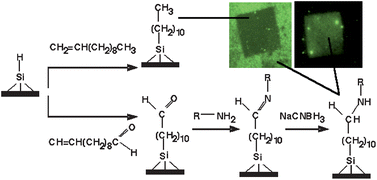We describe a simple method for the covalent immobilisation of proteins to hydrogen-terminated silicon surfaces and demonstrate various protein detection strategies. Using hydrosilation chemistry, 1-undecenylaldehyde is attached to the surface through stable Si–C bonds; the reaction occurs primarily via the vinyl group and mainly aldehyde groups are presented at the top surface of the monolayer. Proteins are then captured by reaction with their surface lysines. The proteins are bound via a Schiff base, whose formation is reversible, but can be fixed by reduction with cyanoborohydride in a one-pot reaction. Using standard methods of patterning, we were able to specifically localise proteins (urease, amyloid beta (Aβ1–42), GFP and TolAIII-GFP) with little non-specific adsorption at non-reactive sites. We characterised the immobilised proteins by X-ray photoemission spectroscopy, atomic force microscopy and FTIR, and showed that they retain their functionality using potentiometry, fluorescence and coupled antibody systems with chromogenic substrates. We also exploited the conductivity of the silicon substrate to demonstrate electrochemical detection of surface-bound proteins. These protocols will aid the development of protein biochips based on silicon, which gives rise to the possibility of detecting protein–protein and protein–small molecule interactions electronically. Such chips would be expected to be of utility for comparative proteomics and in molecular medicine, drug discovery and diagnostics.

You have access to this article
 Please wait while we load your content...
Something went wrong. Try again?
Please wait while we load your content...
Something went wrong. Try again?


 Please wait while we load your content...
Please wait while we load your content...